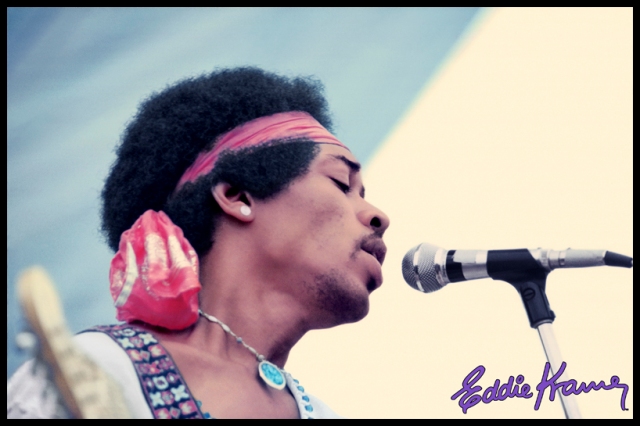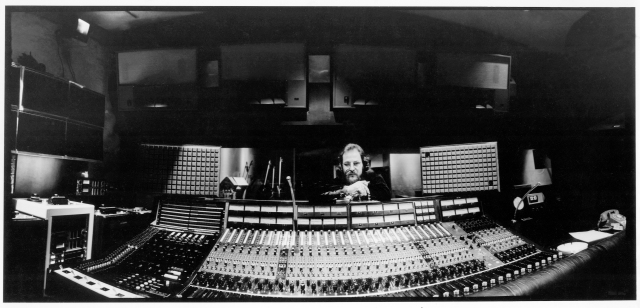
Stereophonic Smoking: Here’s a cool shot Eddie Kramer took of Jimi two-fisting it in the studio, alternating between a regular cigarette and a variation of the herbal variety. As they say, inspiration comes in all forms! Photo courtesy of the Eddie Kramer Archives

Jimi and Jagger: Two titans swap brownie recipes backstage at Madison Square Garden, 1969, where the Stones were performing. As the story goes, Jimi rang up Eddie Kramer, said he was going to see the Stones, and invited him to tag along. Good thing Eddie brought his camera! Photo courtesy Eddie Kramer Archvies (go to(http://eddiekramerarchives.com) to see the photos taken that night and much more

As we remember him: Hendrix and headband closes Woodstock, 1969. Photo by Eddie Kramer (visit http://eddiekramerarchives.com for the story behind this shot and so much more.

Eddie in his element: Kramer behind the proverbial boards, mixing up another masterpiece. Photo courtesy of the Eddie Kramer Archives

Audio-visual experience: Producer-engineer-photographer Eddie Kramer (in 2013), whose eyes and ears helped bring us Jimi Hendrix. Photo courtesy Eddie Kramer Archives.

The poster from Eddie Kramer’s 2006 photography exhibit at the Paradise Lounge in Boston, where he chatted with fans, fielded questions from the audience, told stories, and inscribed my copy of “Electric Ladyland” with the phrase: “Remember, UP is louder!” (From Jonathan Perry’s personal collection)

Kramer’s Keith: Eddie trains his camera on Keith Richards of the Rolling Stones backstage at Madison Square Garden, November 1969. Photo kind courtesy Eddie Kramer Archives.

Page and Plant: Eddie Kramer’s work with Led Zeppelin also extended behind the lens as well as behind the boards. Here’s Zep guitarist Jimmy Page working out a song with singer Robert Plant at the Rolling Stones Mobile Recording Studio at Stargroves, Stones singer Mick Jagger’s home (well, one of them anyway!). Photo kind courtesy of the Eddie Kramer Archives
Eddie Kramer is one of the few people in the world who can tell stories first-hand about the occasions when Jimi Hendrix asked him to make a track “sound purple”. Or the time Led Zeppelin singer Robert Plant, recording his vocals outdoors on the lawn of Mick Jagger’s country estate, directed Kramer to keep the sound of an airplane accidentally recorded during the taping of Jimmy Page’s guitar track (the exchange was preserved for posterity on Zeppelin’s song, “Black Country Woman”). Or the time he played percussion during a couple of recording sessions with the Rolling Stones, and hung out with them backstage at Madison Square Garden.
As a producer and engineer spanning more than 40 years, Kramer, 63, has overseen and worked on some of the most influential recordings and significant albums of all-time, among them Hendrix’s ground-breaking “Are You Experienced?” (in fact, all of Hendrix’s studio albums); no less than five Led Zeppelin albums; the Rolling Stones’ “Beggars Banquet”; and works by Santana, Small Faces, Traffic, David Bowie, the Beatles, the list goes on and on and on.
That Kramer helped shape the sound and course of rock music at a pivotal moment in its history should come as no surprise to anybody who’s grown up gazing at the gatefold LP credits while “Whole Lotta Love” or “Voodoo Chile” blasted from the stereo speakers. That he also took pictures while he was at it – literally more than a thousand of them – is a more recent revelation.
“I’d keep the camera next to me,” says Kramer over the phone from Los Angeles, during a break from (what else?) recording a new rock band led by Kid Rock guitarist Kenny Olson. ” It was my constant companion and it was always loaded and ready to go. Sometimes I would be working the board and the artist would be sitting behind me on the couch, and I’d wheel around in my chair and just snap away and keep working with the other hand.”
“From The Other Side of the Glass” is a new traveling exhibition that features a selection of Kramer’s remarkable, intimate (and until now, little seen) photographs of three of rock’s best known subjects – Hendrix, Zeppelin, and the Stones – at work and at play. Drawn from roughly 450 images at his Kramer Archives website (http://eddiekramerarchives.com), the exhibit comes to the Paradise Lounge April 4 and will remain through May 20. Also tied in with the exhibit is “Experience Hendrix! A Celebration of the Music Of Jimi Hendrix”, a multi-media event scheduled to take place April 6 at Axis. Kramer will be on hand with Billy Cox, bassist for Hendrix’s post-Experience outfit, Band of Gypsys, for a question & answer session and a special screening of the recently released film, “Jimi Hendrix: Live At Woodstock”, whose newly restored soundtrack Kramer engineered.
In retrospect it is hard to believe, given the considerable clout of the superstars captured by Kramer’s camera, that the then-24-year-old British engineer began snapping pictures as a lark after a colleague at England’s Olympic Studios sold him a Pentax camera. “This was a hobby,” Kramer says. “This was something that I did for fun, purely for enjoyment, and not really meant to be shared with anybody other than myself. When I first came to the states, I befriended (photographer) Linda Eastman, who later became Linda McCartney, and she showed me some of her stuff which was brilliant, of course. I was encouraged by her and so continued taking pictures until 1972. But I had no preconceived notion about it. Literally, the stuff was sitting in a box.”
Flash-forward to 1982 and enter then-Boston University student John McDermott. McDermott would, years later, collaborate with Kramer on “Setting The Record Straight”, a biography of the guitarist, as well as go on to become producer and catalog manager for Experience Hendrix (the family-owned company that during the ‘90’s successfully won the rights to Jimi’s once litigation-riddled catalog). After the fledgling Hendrix historian McDermott interviewed Kramer for a prospective article on the musician, the engineer opened his box of unpublished photographs. McDermott, who still lives in Boston, was amazed and told Kramer that people should really see them someday. (Kramer says he’s since discovered hundreds more photographs and negatives, which he hopes to eventually include in a proposed book of the same name as the exhibit).
“Of course they’re wonderful,” McDermott, 43, says of the photographs. “What Eddie had was tremendous access to all of these great artists, and that was what really made (the photographs) so unique. These weren’t arranged photo sessions or posed portraits. It was a real window into a world no one really had much opportunity to see. Back then it was a friendly thing, very loose.”
“The feeling of camaraderie was there,” Kramer agrees. “Everybody was very nice about it. Nobody said put that damn (camera) away and there were no managers or record companies saying no, you can’t do that. But I would pick my spots – I would never do something that would interfere with the session. I couldn’t. My main function was to record the guy (Hendrix), not take pictures of him.”
Still, there were ample opportunities for both. During what Kramer describes as the “golden age” of rock that coincided with his shooting years between 1967 and 1972, the parade of pop stars flashing before Kramer’s eyes, and his trusty camera, seemed to never cease. Sounding as if he still gets a contact buzz from the memories, Kramer blithely recalls the Stones as “the most wonderful rock and roll dysfunctional family ever built – the great arbiters of the rock image. Does it get any better than Keith (Richards)?” That said, Kramer believes Stones founder Brian Jones, who was subsequently ousted and who died in his swimming pool in 1969, “was the essence of the Rolling Stones. He was the one guy in the band you could always depend upon to come up with something very unusual musically, and challenging. I thought he was a terrific character and he had a marvelous little evil glint in his eye most of the time. And he and Jimi got on extremely well. The relationship between Jimi and Brian was very strong.”
Indeed, of all the many associations Kramer’s had over the years, none has ever been as fruitful or enduring as his short yet fertile friendship with Hendrix, which lasted from 1967 until the guitarist’s death three years later. Kramer still remembers the first time the young guitarist (whom a colleague had described in advance to Kramer as an “American chappie with rather large hair; you should record him, he’s good”) walked through the door at Olympic Studios. One thing immediately struck Kramer about the young man who would change the course of rock music forever.
“Jimi was so shy,” Kramer says. “He never said a word in the beginning. He was very polite, very reserved, but once he plugged in and started playing I realized, ‘this is pretty special’. I had heard a couple of singles he had done, but hearing him playing right there in the same room was a whole different ball game. But very quickly, once I established the sound that he liked, we got on extremely well and we could communicate – even though he would describe sounds to me as colors, like, ‘Man, I want it to sound kinda purple, you know what I mean, man?’ And I would come up with a sound that was purple. We inspired each other, I guess. He certainly inspired me.”
Contrary to Jimi’s public image — and his free-spirited, freewheeling attitude away from the studio — Kramer recalls Hendrix as a marvelously focused and hard-working master of his instrument. Sure, there was “this wild, crazy guy on the outside, but a very cool, highly disciplined individual in the studio — the complete antithesis of what the public personae was,” Kramer says. “When you think of his heritage, it’s one of discipline [working brutally long hours as a sideman on the barnstorming chitlin circuit]. His father [Al Hendrix] was fairly strict, and with Jimi going into the Army early on, there was another set of disciplines.”
When Hendrix finally broke away from the chitlin circuit, after backing the likes of Little Richard, Curtis Knight, and other ’50s and ’60s R&B artists and soul singers, his manager, ex-Animals bassist Chas Chandler, insisted on working quickly, efficiently, and cost-effectively in the studio. When it was time to record a single, for instance, Chandler would book only three hours — not three days — of studio time. “Jimi had to take that wonderful genius of his and compress it into a three and a half minute song. So you’d get these highly compacted, concentrated solos, and beautiful, polished gems in a short space of time,” Kramer says. “To me, the core of Jimi’s playing is that discipline. He mastered his instrument, he knew it backwards, sideways, and forwards.”
On the surface, Jimi’s musical genius may have seemed like a terrifically exciting opportunity, and obvious boon, for a young producer and engineer (Kramer was actually one year younger than Hendrix) with a bounty of ideas and imagination of his own. And, of course, it was certainly both of those things. But there were dilemmas, if not exactly “challenges,” that came with the territory of working with an artist who seemed to be operating on an entirely different plane of sound, thought, and musical sensibility than most mere mortals.
“With Jimi it was more a question of, ‘How on earth do I take what he is doing, which is so radical and so loud, so unusual — and the dynamics were so wide — how does one capture that on tape’?” Kramer says, sounding awed and even slightly perplexed more than three decades later. “That’s what I had to learn how to do. Fortunately, my background being classical music as a pianist, and also learning how to record classical music, gave me the ability, and a wider palette, to be able to capture Jimi.” And he continues to do so. Under Kramer’s continued, protective supervision of Hendrix’s catalog, and new projects in the works that Kramer and the Hendrix family hopes stay true to their creator’s seemingly limitless vision, Jimi’s legacy remains as towering as it ever was. When you consider that the man released merely three albums (four if you count the double-LP masterwork, “Electric Ladyland”) during his brief 27 years on earth, it can be argued that Jimi Hendrix’s musical impact and influence has been as significant as that of any artist.
“Every successive generation of kids seems to gravitate towards Jimi’s music because he was the boss, let’s face it,” Kramer says. “He was the master, a maverick and a total stand-alone genius. Nobody has really approached his level of playing, I don’t think. Stevie Ray Vaughan and Eric Clapton and Jeff Beck and people like that who were wonderful players — the list goes on and on of great players and wonderful musicians — but everybody pays homage to Mr. Hendrix. I’m thrilled and honored to have been a part of that whole process. He changed many people’s lives, mine included, and I was very lucky. I was at the right place at the right time.”
Watch Jimi play acoustic 12-string on “Hear My Train A’ Comin'” from the superb 1973 documentary, “Jimi Hendrix,” (highly recommended!) here:http://www.youtube.com/watch?v=IPtv14q9ZDg
Never before, never since: A very cool psychedelic video (smoke ’em if you got ’em) that gives you an idea of what kind of showman, besides musician, Jimi was, set to his studio version of Bob Dylan’s “All Along The Watchtower,” a song by his favorite artist. (Dylan himself was quoted as saying that after hearing Jimi’s definitive version, he tried — and, naturally, failed — to play Hendrix’s electric arrangement in concert from then on. This one’s for Rodney, wherever you are. http://www.youtube.com/watch?v=7Bnpx4DCojQ
Watch Jimi play (although that is a gross understatement for what he does here) maybe the baddest-ass song ever, “Voodoo Child (Slight Return)” live for a Berkeley audience that has its collective jaw dropped here: http://www.youtube.com/watch?v=qbC2U_NoQDU
Be sure to check out the Official Jimi Hendrix website run by his family: http://www.jimihendrix.com
Be sure to check out Eddie Kramer’s official website: http://eddiekramerarchives.com


[…] STILL REIGNING, STILL DREAMING: Jimi Hendrix Producer Eddie Kramer On The Making Of A Legend (rpmlifeinanalog.com) […]
LikeLiked by 1 person
Incredible pictures, phenomenal writing. No one does it like Kramer and Perry!!
LikeLiked by 1 person
[…] STILL REIGNING, STILL DREAMING: Jimi Hendrix Producer Eddie Kramer On The Making Of A Legend […]
LikeLiked by 1 person